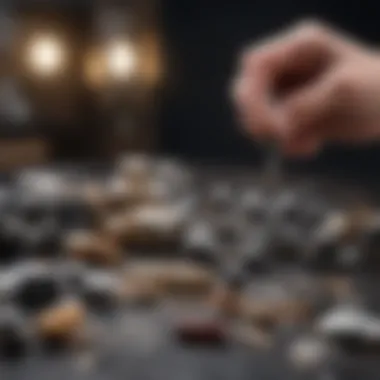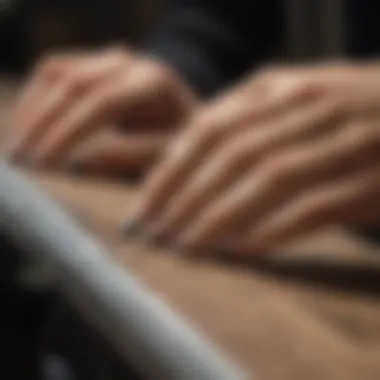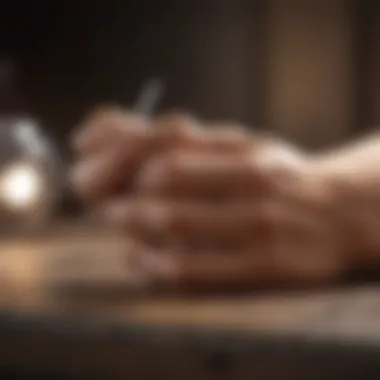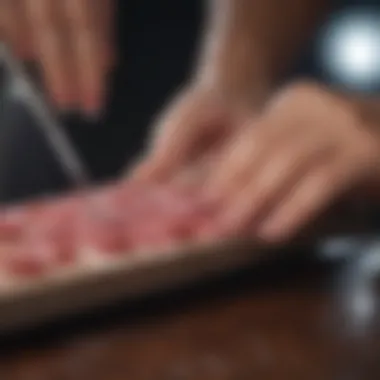The Essential Guide to Hang Nail Tools and Techniques


Intro
Hang nails, though small and often overlooked, can cause significant discomfort and even contribute to more serious nail health issues. They arise when the skin around the nail pulls away, leading to a sharp piece of skin that can snag and tear. This guide explores the essential tools and techniques to manage hang nails effectively, promoting overall nail health and well-being.
Understanding hang nails begins with acknowledging their potential impact on both physical and mental health. Persistent pain from these minor afflictions can lead to frustration and stress, emphasizing the importance of proper management and prevention strategies.
In this guide, we will provide insights on various tools available for efficient hang nail care, their proper usage, alternative methods, and safety tips. These strategies aim to equip readers with the knowledge needed for effective nail health management. Readers will find practical advice on incorporating these techniques into their routines, ensuring healthier, well-maintained nails.
Understanding Hang Nails
Understanding hang nails is crucial for maintaining overall nail health. While seemingly minor, hang nails can lead to discomfort, potential infections, and further nail issues if not addressed properly. This section provides insights into the nature of hang nails, including their definition, causes, and how to identify them. By grasping these fundamentals, readers can appreciate the significance of employing the right tools and techniques for effective management.
Definition and Description
A hang nail is primarily a small, torn piece of skin near the fingernails or toenails. It often occurs when the skin around the nail becomes dry or damaged. Although not a true nail issue, hang nails can be painful and may catch on clothing, irritate, or even bleed. Differentiating them from other nail or skin problems is vital to ensure appropriate treatment and care. Recognizing that hang nails derive from a specific skin condition can help one avoid mishandling or incorrectly treating the area.
Causes of Hang Nails
Several factors contribute to the occurrence of hang nails. Common causes include:
- Dry skin: Excessive exposure to cold weather, harsh soaps, or chemicals can dry out the skin around the nails.
- Nail biting: Biting the nails can also damage the skin and lead to hang nails.
- Trauma to the nails: Any injury, even minor, such as bumping the nail against a hard surface, can result in skin tears.
- Health conditions: Certain medical conditions, like eczema or fungal infections, can contribute to skin problems around the nails.
Understanding these causes can guide readers in taking preventative measures to improve their nail health and minimize the risk of developing hang nails.
Symptoms and Identification
Identifying a hang nail is primarily about observing the specific characteristics. Symptoms include:
- A small piece of skin that is ripped or torn near the nail's edge.
- Redness or irritation around the affected area.
- Sometimes, mild pain or discomfort if the hang nail gets caught on clothing or other surfaces.
It is essential to differentiate hang nails from more serious conditions like ingrown nails or infections. Hang nails will typically appear as isolated skin issues without the signs of infection, such as pus or intense swelling. Early recognition allows for timely treatment, reducing the risk of further complications and promoting good nail hygiene.
The Role of Hang Nail Tools
Hang nail tools serve a critical function in maintaining nail health. Proper tools not only facilitate the removal of hang nails but also reduce the likelihood of complications such as infections. Using the right tool is imperative for achieving clean and precise results. Without these tools, individuals may resort to using fingers or other unsuitable instruments, which can lead to injury and worsen the condition of the nails.
Importance of Using Tools
Utilizing tools specifically designed for hang nails ensures that the removal process is much safer. Tools like cuticle nippers or nail scissors provide a level of precision that is hard to achieve otherwise. By investing in quality tools, individuals can significantly reduce potential damage to the surrounding skin and nail area. Proper tools help minimize pain and allow for a more efficient process of hang nail management.


Types of Tools Available
Different tools serve unique purposes in managing hang nails. Understanding these tools is essential for effective nail care. Here’s a closer look at some commonly used tools:
Cuticle Nippers
Cuticle nippers are designed to trim excess cuticle and hang nails effectively. One of their key characteristics is the sharp and angled blades that facilitate precision cutting. They are a popular choice because they allow for thorough management of hang nails without much pressure. The unique feature of cuticle nippers is their ability to cradle the nail bed, providing a clean cut. However, they can be misused, leading to cuts in the surrounding skin if not handled properly.
Nail Scissors
Nail scissors are versatile instruments meant for cutting both nails and hang nails. Their design features sharp blades, making them effective in eliminating hang nails with minimal effort. This tool is popular for their dual functionality, saving space in nail care kits. Nail scissors are excellent for detailed work, yet they can sometimes result in uneven cuts if not used with care.
Emery Boards
Emery boards are essential for smoothing rough edges after hang nail removal. They come with differing grit levels, allowing for a customized approach based on nail needs. Their most significant advantage is their ability to finish off the process nicely, ensuring that nails do not catch on fabrics or other surfaces. They are beneficial for regular maintenance, but they are not designed for removing hang nails directly.
Nail Files
Nail files are similar to emery boards but are often more portable and come in various materials. They help refine the edges after using other tools. A critical characteristic is their surface texture, which can vary from fine to coarse. Nail files make it easy to maintain nail shape and smoothness, useful for preventing future hang nails. However, they may not address the underlying issue of excessive hang nails itself.
Choosing the Right Tool
Selecting the right tool involves understanding individual needs and preferences. Consider the frequency of hang nails and the specific areas that need attention. Factors such as ease of use, comfort, and technique should influence the selection process. Investing in quality instruments is essential. Regular maintenance and proper storage of tools will also prolong their life and effectiveness.
Proper Usage of Hang Nail Tools
Understanding the proper usage of hang nail tools is essential for anyone who deals with nail care, whether you are a professional or simply taking care of your own nails. Using tools correctly can help prevent further injury and keep nails healthy. The efficacy of treatment and prevention of hang nails largely hinges on this knowledge. Improper usage can lead to complications such as infections or worsening of the current problem. Thus, it is critical to ensure precision and care in handling these tools.
Technique for Safe Removal
When it comes to safe removal of hang nails, follow a few steps. First, ensure your hands are clean. Wash them thoroughly with soap and water. It is also a good idea to soak your fingers in warm water for a few minutes. This softens the skin around the nail, which makes it easier to remove the hang nail. Use cuticle nippers or nail scissors to gently trim the hang nail, cutting it close to the skin but not too deep to avoid injury.
Be cautious not to jerk the tool or pull on the hang nail. Always cut in a steady motion. If you feel any resistance, stop; it may be attached to the sensitive skin. This can lead to pain and potential infection if not handled properly. Always seal any exposed area with a suitable antiseptic afterward to protect from germs.
Maintaining Tools Effectively
Keeping hang nail tools in pristine condition is vital for both longevity of the tools and health of your nails. Proper maintenance involves regular cleaning and safe storage of the tools. Each aspect contributes significantly to the overall usage of hang nail tools.
Cleaning and Sterilization
The cleaning and sterilization of tools is not just a best practice; it is essential. Regular cleaning removes dirt and debris that can harbor bacteria. Use warm, soapy water to wash the tools after each use. For deeper sterilization, consider using rubbing alcohol or a solution specifically designed for cleaning salon tools. The key characteristic of this practice is its preventive nature, reducing the chance of infections caused by contaminated tools.


A unique feature of cleaning is the ability to extend the life of your tools. Properly cleaned and sanitized tools do not dull or rust as quickly, ensuring they are effective when you need them. The disadvantage, however, is it takes time and discipline to maintain this routine, but it pays off by ensuring safety and efficacy in nail care.
Storage Practices
The storage practices of hang nail tools can significantly influence their lifespan and effectiveness. Tools should be stored in a clean, dry place away from moisture to prevent rust and degradation. A dedicated tool case or a small pouch works well for this purpose. This is a key characteristic of organized storage, making it easier to find tools when needed and ensuring they remain in good condition.
A unique aspect of proper storage is the ease of access and safety. Tools are less likely to be misplaced or damaged if they are properly stored. On the downside, improper storage can lead to accidents, such as tools falling and causing injury. By developing good storage practices, you maintain not only the condition of your tools but also your overall safety when performing nail care.
Safety Considerations
Safety considerations are crucial in any self-care process, especially when it comes to managing hang nails. Understanding the risks involved with improper tools and techniques can help prevent further complications. Hang nails are not just an aesthetic issue; they can lead to serious infections and discomfort. Prior attention to safety can enhance overall well-being and promote better nail health.
Preventing Injury
Preventing injury when dealing with hang nails starts with using appropriate tools and techniques. Always ensure your tools are sterilized before each use. This reduces the chances of infections after a hang nail has been removed. When using nail scissors or cuticle nippers, make sure to apply gentle pressure and avoid cutting too close to the skin. Such practice minimizes the risk of cutting into the skin, which can cause bleeding and increase susceptibility to infections.
Proper techniques during removal are also critical. To remove the hang nail safely, you should grasp the hang nail gently with the tool and pull slightly to avoid tearing the skin. Then, carefully snip the hang nail away, ensuring a clean cut. Additionally, aftercare is important; applying an antiseptic or a soothing ointment can help create a barrier against germs.
It is essential to listen to your body as well. If a hang nail is causing significant pain or discomfort, seeking professional help can prevent further injury. Putting pressure on sensitive areas can result in wounds that take longer to heal.
Recognizing Infections
Recognizing infections early can prevent more severe health issues. After removing a hang nail, keep an eye on the affected area for any signs of redness, swelling, or increasing pain. If you experience pus formation, it is often an indication of an infection that requires immediate attention.
Common signs of infection:
- Increased redness around the hang nail area
- Persistent or worsening pain
- Swelling that does not subside
- Formation of pus, or any discharge
- A fever in some cases
If you notice any of these symptoms, do not hesitate to consult a healthcare professional. Early intervention can often mitigate complications and ensure faster recovery. A proactive approach to recognizing potential infections will support your efforts in maintaining healthy nails and skin.
Alternative Methods for Managing Hang Nails
Managing hang nails effectively requires more than tools and techniques. Exploring alternative methods brings a holistic approach to nail health. These methods not only address the symptoms but also focus on prevention and overall well-being.
Natural Remedies
Natural remedies for hang nails have gained traction for their efficacy and accessibility. These remedies often utilize common ingredients found in households. Here are some notable options:
- Vitamin E Oil: Known for its moisturizing properties, Vitamin E oil helps in healing and softening the skin around the nails. Simply apply a small amount on the affected area daily to promote healing.
- Coconut Oil: This oil has antimicrobial properties, making it ideal for preventing infections. It also nourishes dry skin. Apply it several times a day, especially at bedtime, for best results.
- Aloe Vera: This plant is renowned for its soothing effects. Aloe vera gel can reduce inflammation and provide moisture. Apply it directly to the hang nail and surrounding skin to alleviate discomfort.
- Honey: Honey has natural antibacterial qualities that can assist in the healing process. Applying honey on the affected area can help prevent infection while moisturizing the skin.
These natural remedies are easy to incorporate. They offer a gentle alternative to harsher treatments, aligning with a wellness-focused lifestyle.


Preventative Care and Practices
Preventative care plays a crucial role in managing hang nails. Simple habits can greatly diminish the frequency and severity of hang nails. Consider these practices:
- Regular Moisturizing: Keeping hands and nails hydrated is essential. Use hand creams frequently, particularly after washing hands. Look for products with shea butter or glycerin for better hydration.
- Avoiding Nail Biting: This habit can lead to hang nails and irritation. Find ways to curb this behavior, such as stress management techniques or finding a fidget toy to occupy your hands.
- Gentle Handling of Nails: Be cautious during activities that may stress the nails, such as opening cans or peeling fruits. Using tools instead of fingers can prevent accidental tears that lead to hang nails.
- Nail Care Routine: Establish a routine that includes regular trimming of nails. Keeping nails short reduces the chance of hang nails developing. Always use sharp and clean tools when performing nail care.
- Balanced Diet: A diet rich in vitamins and minerals promotes healthy nails. Include foods high in biotin, omega-3 fatty acids, and zinc, as these nutrients bolster nail strength and overall skin health.
By adopting these preventative care practices, individuals can significantly reduce their risk of developing hang nails, leading to healthier nails and a lower likelihood of pain or irritation.
Takeaway: Using natural remedies alongside preventative care is a strategic approach to managing hang nails. This combination enhances nail resilience and promotes overall skin health.
Questions and Answerss About Hang Nail Tools
The inclusion of frequently asked questions provides valuable insights regarding hang nail tools. By addressing common myths and practical advice, readers gain a clearer understanding of how to manage hang nails effectively. These FAQs are essential for demystifying misconceptions, helping to establish informed practices that promote nail health.
Common Myths Debunked
There are several prevalent myths surrounding hang nails and their tools. These myths can mislead individuals into improper care methods. Here are some common beliefs debunked:
- Myth: Hang nails are harmless and do not require care.
Reality: This is untrue. Neglecting hang nails can lead to infections and more severe conditions. - Myth: Only professionals can use cuticle nippers.
Reality: While professionals have training, many non-professionals can safely use tools with proper instruction and care. - Myth: All nail tools are the same.
Reality: Different tools serve unique purposes. Using the right tool enhances safety and efficacy.
"Understanding the truth about hang nails and the tools used can significantly enhance care routines."
Tips for Non-Professionals
For non-professionals, managing hang nails and selecting tools correctly is vital. Here are some practical tips:
- Educate Yourself:
Learn about various tools and their specific functions. - Start Simple:
Begin with basic tools like emery boards and nail scissors to gain confidence. - Focus on Hygiene:
Always clean your tools before and after each use to prevent infections. - Practice Gentle Techniques:
Avoid cutting too close to the skin to minimize pain. - Know When to Seek Help:
If a hang nail becomes infected or does not heal, consult a healthcare professional.
By following these suggestions, non-professionals can navigate hang nail care more effectively and safely.
Culmination
In this article, we have delved into the various aspects of hang nail tools and techniques, emphasizing their significance in maintaining nail health. Understanding how to effectively manage hang nails is crucial for numerous reasons. Poor nail health can lead to discomfort, infection, and even complications. Hence, utilizing the right tools appropriately not only prevents these issues but also promotes self-care and confidence.
Recap of Key Points
The journey through this guide has highlighted essential components:
- Understanding Hang Nails: We began with defining hang nails, exploring their causes, and discussing symptoms for better identification.
- Role of Tools: The significance of using specialized tools such as cuticle nippers, nail scissors, and files was thoroughly explained. Each tool has a defined purpose that contributes to effective hang nail management.
- Proper Usage: Safe removal techniques were emphasized alongside the importance of maintaining tools through cleaning and proper storage practices.
- Safety Considerations: Strategies to prevent injury and recognize signs of infection were discussed. Awareness of these factors is vital in ensuring safe practices.
- Alternative Methods: We considered natural remedies and preventative care, recognizing that holistic approaches often lead to better health outcomes.
- FAQs: Common myths about hang nails and practical tips for non-professionals were dispelled, enriching the reader's knowledge.
Encouragement for Self-Care
Practicing self-care is more than a trend; it is a necessity. Incorporating the knowledge gained from this guide into daily routines can significantly enhance nail health. Simple actions such as regularly trimming hang nails, cleaning tools, and moisturizing can prevent future occurrences.
Remember that taking care of your nails is an investment in your overall well-being. When you prioritize your health, you create a foundation for not only better nails but also improved self-esteem.
Stay aware of your body and the signals it sends. This consciousness will lead to better choices for your nail care routine. Embrace the responsibility of maintaining your nails, and it will lead to visible benefits in your life.



